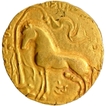This Lot is closed.
- P-Auction # 31
- Bids: 1
- Views:473
| Start Price 400000 | Estimated Price 400000-500000 |
| login, to view Hammer value | |
| Quick Description | ||||
|---|---|---|---|---|
| Denomination | Gold Dinara | Metal | Gold | |
| Full Description: Gupta Empire, Samudragupta (345-375 AD), Gold Dinar, "Ashvamedha" type, Obv: a sacrificial horse standing facing left, behind a sacrificial post (Yupa), which is shown as an elaborate stand with streamers and ribbons flying in the wind; the Yupa has an ornamental pedestal with two steps which are slightly bent in towards the center, Brahmi letter 'Si' (Siddam) between the horse legs, Brahmi legend "Rajadhiraja (prithivimavitva divam jayatyahru)ta vajimedha" around the field, Rev: the chief queen in the guise of a goddess standing left on a lotus-shaped pedestal, carrying a fly-whisk (Chauri) in her right hand, which is placed on her shoulder and holding a towel in her left, Brahmi legend "Ashvamedha Parakramah" on the right field and ritual needle (Soochi/ceremonial spear with ribbons) on the left, 7.59g, 21.15mm, (Variant of Altekar, Bayana Hoard # Pl. IV-3-5- Unlisted type), choice very fine, Exceedingly Rare. Note: A stylized version of the queen is seen on this coin’s reverse. Her lithe figure is representative of the ideal feminine form as can be seen reiterated in several classical texts from the Indian subcontinent. This depiction usually occurs on Gupta coins bearing the legend ‘Hayamedha Parakramah’ and therefore it has been suggested that this type may have been struck at a different mint or engraved by a different atelier than the usual Ashvamedha Parakramah type. The Ashvamedha was one of the grandest of the Vedic religious ceremonies of ancient India, and was performed by a king to celebrate or, to be more precise, affirm their imperial sovereignty. The ceremony is described in detail in various Vedic writings, particularly the Shatapatha Brahmana. | ||||


